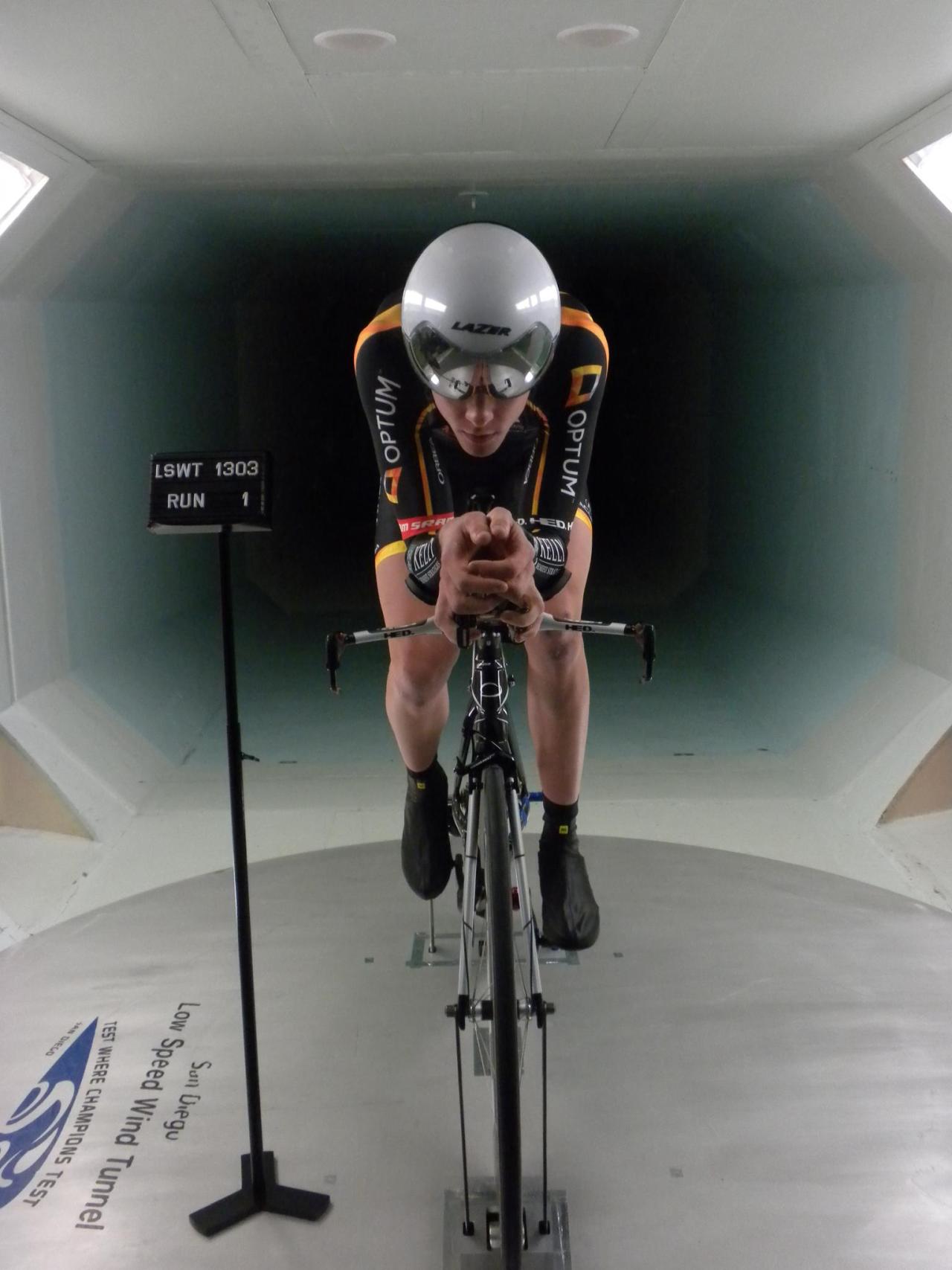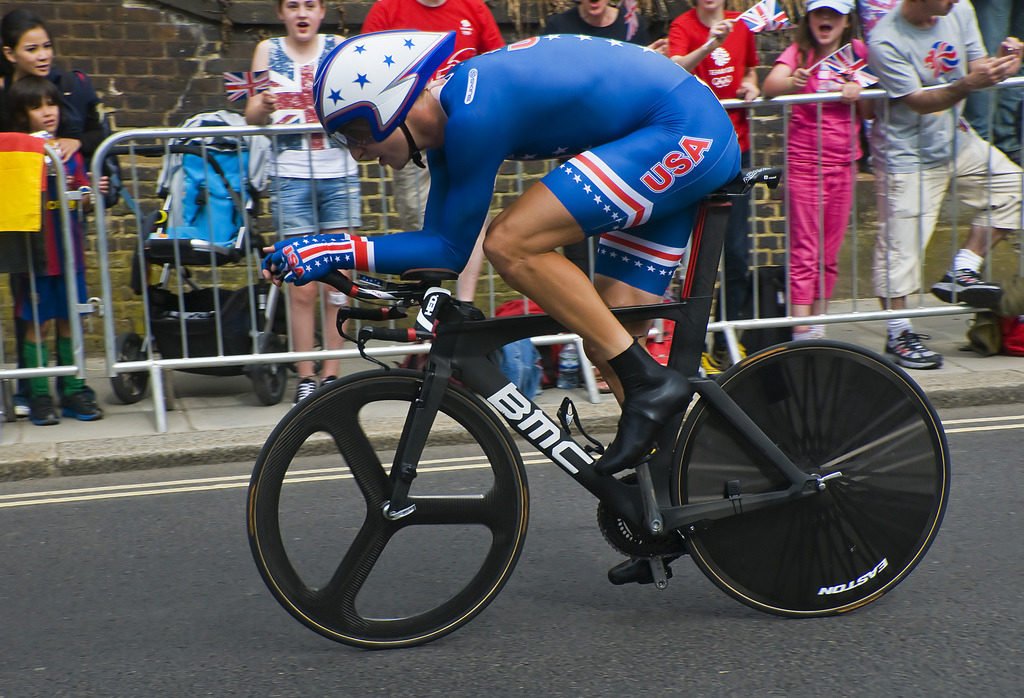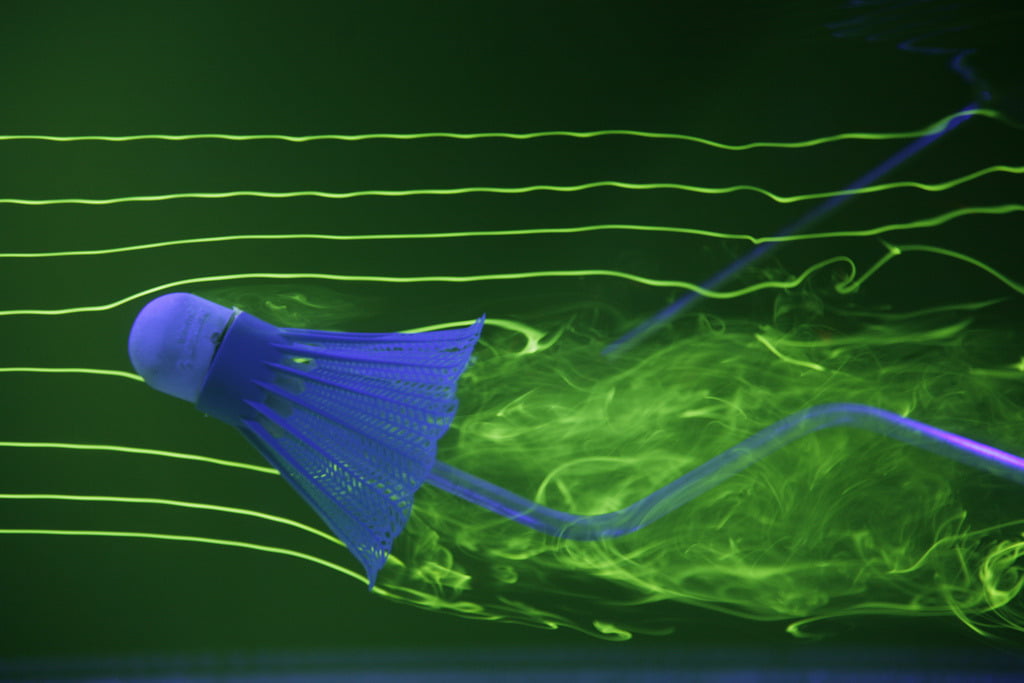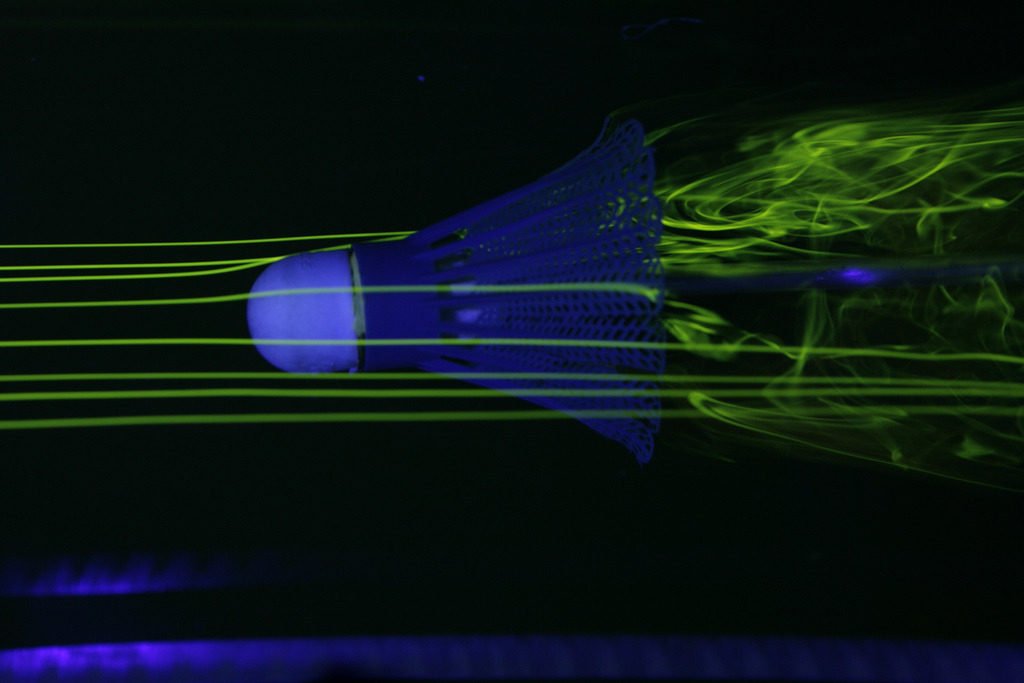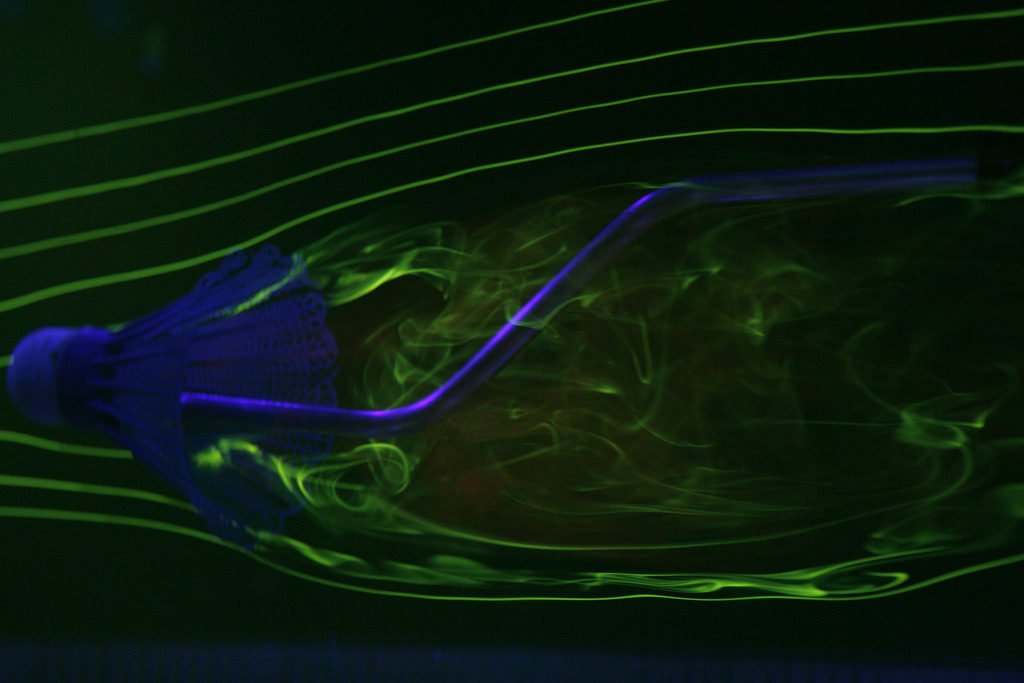Spinning an object in motion through a fluid produces a lift force perpendicular to the spin axis. Known as the Magnus effect, this physics is behind the non-intuitive behavior of football’s corner kick, volleyball’s spike, golf’s slice, and baseball’s curveball. The simulation above shows a curveball during flight, with pressure distributions across the ball’s surface shown with colors. Red corresponds to high pressure and blue to low pressure. Because the ball is spinning forward, pressure forces are unequal between the top and bottom of the ball, with the bottom part of the baseball experiencing lower pressure. As with a wing in flight, this pressure difference between surfaces creates a force – for the curveball, downward. (Video credit: Tetra Research)
Tag: sports

Reader Question: Drafting in Triathlons
Reader juleztalks writes:
I’ve just entered an amateur triathlon, and there’s a whole load of rules about not “drafting” in the cycle stage (basically, not sitting in other cyclists’ slipstream). However, there are no such rules for the swim or run stage; I thought the effects would be the same from drafting other swimmers and runners. Any ideas?
As in many endurance sports, it’s all a question of energy savings from drag reduction. Drag on an object, like a triathlete, is roughly proportional to fluid density (air for cycling or running, water for swimming), frontal area, and the velocity squared. Because drag increases more drastically for an increase in velocity, it makes sense one would worry most about drag when one’s velocity is highest – on the bike.
Drafting has major benefits in cycling and can reduce drag on a rider by 25-40%. Aerodynamic drag accounts for 70% or more of a cyclist’s energy expenditure, so that reduction can really add up. The energy saved by drafting during cycling can even increase a triathlete’s speed during a subsequent running leg. So it makes sense for a sport’s governing body to be concerned with it.
That said, there’s plenty of room for drag reduction in swimming as well. Even though the velocities are much lower, water’s density is 1,000 times higher than air’s, generating plenty of drag for an athlete to overcome. For swimmers at maximum speed, drafting can reduce drag by 13-26%, depending on relative positioning. Such drafting has been found to increase stroke length and may (or may not) improve subsequent cycling performance.
Although a similar reduction in drag is possible by drafting when running, drag on a runner only accounts for about 8% of his/her energy expenditure so such savings would matters very little next to the swimming and cycling legs. There could be some psychological benefits, though, in terms of pacing oneself. (Photo credit: Optum Pro Cycling p/b Kelly Benefit Strategies)

Magnus Force
Physics students are often taught to ignore the effects of air on a projectile, but such effects are not always negligible. This video features several great examples of the Magnus effect, which occurs when a spinning object moves through a fluid. The Magnus force acts perpendicular to the spin axis and is generated by pressure imbalances in the fluid near the object’s surface. On one side of the spinning object, fluid is dragged with the spin, staying attached to the object for longer than if it weren’t spinning. On the other side, however, the fluid is quickly stopped by the spin acting in the direction opposite to the fluid motion. The pressure will be higher on the side where the fluid stagnates and lower on the side where the flow stays attached, thereby generating a force acting from high-to-low, just like with lift on an airfoil. Sports players use this effect all the time: pitchers throw curveballs, volleyball and tennis players use topspin to drive a ball downward past the net, and golfers use backspin to keep a golf ball flying farther. (Video credit: Veritasium)

London 2012: Discus Physics
Like the javelin, the discus throw is an athletic event dating back to the ancient Olympics. Competitors are limited to a 2.5 m circle from which they throw, leading to the sometimes elaborate forms used by athletes to generate a large velocity and angular momentum upon release. The flight of the discus is significantly dependent on aerodynamics, as the discus flies at an angle of attack. Spin helps stabilize its flight both dynamically and by creating a turbulent boundary layer along the surface which helps prevent separation and stall. Unlike many other events, a headwind is actually advantageous in the discus throw because it increases the relative velocity between the airflow and the discus, thereby increasing lift. The headwind also increases the drag force on the discus, but research shows the benefits of the increased lift outweigh the effects of increased drag, so much so that a discus flies further in air than it would in a vacuum. (Photo credits: P Kopczynski, Wiki Commons, EPA/K Okten)
FYFD is celebrating the Olympics by featuring the fluid dynamics of sports. Check out our previous posts, including why corner kicks swerve, what makes a pool fast, how an arrow flies, and how divers avoid splash.

London 2012: Soccer Aerodynamics
Corner kicks and free kicks are tough to defend in football (soccer for Americans) because the ball’s trajectory can curve in a non-intuitive fashion. Known as the Magnus effect, the fluid dynamics around a spinning ball cause this curvature in the flight path. When an object spins while moving through the fluid, it drags the air near the surface with it. On one side of the spinning ball, the motion opposes the direction of freestream airflow, causing a lower relative velocity, and on the opposite side, the spin adds to the airflow, creating a higher velocity. According to Bernoulli’s principle, this causes a lower pressure on the side of the ball spinning with the flow and a higher pressure on other side. This difference in pressure results in a force acting perpendicular to the direction of travel, causing the unexpected curvature in the football’s path. In the case of the corner kick above, the player kicks the ball from the right side, imparting an anti-clockwise spin when viewed from above. As the ball travels past the goal, air is moving faster over the side nearest the goal and slower on the opposite side. The difference in velocities, and thus pressures, creates the sideways force that drives the ball into the goal even without touching another player. The same effect is used in many other sports to complicate play and confuse opponents. In tennis and volleyball, for example, topspin is used to make the ball drop quickly after passing the net.
ETA: Check out this other great example of a free kick sent in by reader amphinomos.
FYFD is celebrating the Olympics by featuring the fluid dynamics of sport. Check out some of our previous posts including the flight of a javelin, how divers reduce splash, and what makes a racing hull fast.

London 2012: Javelin Physics
Few Olympic events can boast as long as history as the javelin. Though the event has existed since the ancient Olympics, humans and our ancestors have been throwing spears for hundreds of millennia. But today’s javelin, oddly enough, is designed so that it cannot be thrown as far as those that came before. After a world record throw in 1984 that nearly reached the edge of the track, the sport’s governing body authorized new rules that shifted the weight of the javelin forward, causing the center of mass of the javelin to lie in front of its center of pressure. This causes the javelin to tip forward in flight, ensuring it will land nose down. Simultaneously, they made changes to the nose of the javelin to reduce its lift during flight, resulting in a javelin that flies only 90% of the previous distance. Since then manufacturers have introduced other innovations to try to increase the javelin’s flight, such as a roughened tail to prevent flow separation, only to later have these changes banned. (Photo credits: Getty Images, Zeenews)
FYFD is celebrating the Olympics by featuring the fluid dynamics of sport. Check out some of our previous posts, including what makes a pool fast, how divers reduce splash, how cyclists get “aero”, and how rowers overcome drag.

London 2012: Diving Physics
Divers twist and spin gracefully in the air, but the highest marks come when they enter the water with little to no splash. This rip entry–named after paper-ripping sound characteristic of such a dive–is possible thanks to fluid dynamics. Any time a solid object enters a still liquid, it tears a cavity into the liquid. The smaller this cavity is, the less the liquid will rebound and splash when the cavity gets refilled. In diving, achieving a small splash requires a couple items. First, the diver will grab his hands over his head to form a flat surface. This will create the initial small cavity through which his body follows. When entering, the diver will keep his body straight and rigid, with arms pressed against his head; this adds stability to keep the diver from letting the force of striking the water at 35 mph affect his body’s form and create splash. Finally, the perfect dive enters vertical to the water surface. This ensures that all of the diver’s body finds its way into that cavity created by the hands without striking any undisturbed water. Once under the water, divers often extend their arms to generate enough drag to slow down quickly. All in all, the rip entry minimizes the cavity size and thus the splash, adding a great exclamation point to a beautiful dive. (Photo credits: Associated Press, Adam Pretty/Getty Images, Nigel Wade, Jed Jacobsohn)
FYFD is celebrating the Olympics by featuring the fluid dynamics of sport. Check out our previous posts on how the Olympic torch works, what makes a pool fast, the aerodynamics of archery, the science of badminton, and how cyclists “get aero”.

London 2012: Cycling Physics
In no discipline of cycling is more emphasis placed on fluid dynamics than in the individual time trial. This event, a solo race against the clock, leaves riders no place to hide from the aerodynamic drag that makes up 70% or more of the resistance riders overcome when pedaling. Time trial bikes are designed for low drag and light weight over maneuverability, using airfoil-like shapes in the fork and frame to direct airflow around the bike and rider without separation, which creates an area of low pressure in the wake that increases drag. Riders maintain a position stretched out over the front wheel of the bike, with their arms close together. This position reduces the frontal area exposed to the flow, which is proportional to the drag a rider experiences.
Special helmets, some with strangely streamlined curves, are used to direct airflow over the rider’s head and straight along his or her back. Both helmets and skinsuits are starting to feature areas of dimpling or raised texturing. These function in much the same way as a golf ball; the texture causes the boundary layer, the thin layer of air near a surface, to become turbulent. A turbulent boundary layer is less susceptible to separating from the surface, ultimately leading to lower drag than would be observed if the boundary layer remained laminar. Wheels, skinsuits, gloves, shoe covers, and even the location of the brakes on the bike are all tweaked to reduce drag. In an event that can be decided by hundredths of a second between riders, every gram of drag counts. (Photo credits: Stefano Rellandini, POC Sports, Reuters, Paul Starkey, Louis Garneau)
FYFD is celebrating the Olympics by featuring the fluid dynamics of sports. Check out our previous posts on how the Olympic torch works, what makes a pool fast, the aerodynamics of archery, and the science of badminton.

London 2012: Badminton Physics
Unlike most racket sports, badminton uses a projectile that is nothing like a sphere. The unusual shape of the shuttlecock not only creates substantial drag in comparison to a ball but increases the complexity of its flight path. The heavy head of the shuttlecock creates a moment that stabilizes its flight, ensuring that the head always points in the direction of travel. The skirt, traditionally made of feathers though many today are plastic, is responsible for the aerodynamic forces that make the shuttlecock’s behavior so interesting.
Measuring the drag coefficient of the shuttlecock, modeling its trajectory and behavior in the four common badminton shots, and even attempting computational fluid dynamics of the shuttlecock are all on-going research problems in sports engineering. (Photo credit: Rob Bulmahn)
FYFD is celebrating the Olympics with the fluid dynamics of sports. Check out our previous posts on how the Olympic torch works, what makes a pool fast, and the aerodynamics of archery.

London 2012: Archery Physics
Archery is one of the oldest Olympic sports, but the physics involved are remarkably complex. Even looking only at the flight of the arrow, the problem is hardly simple. The heavy point of the arrow makes it front-heavy, and the fletches on the back of the arrow provide additional surface area on which air can act. This means that the center of mass of the arrow–where gravity acts–is further forward than the center of pressure–where aerodynamic forces act. This results in the aerodynamic forces helping to stabilize the flight of the arrow. To see why this is important, try throwing a dart fletching first!
When an arrow is fired from a bow, as in the high speed video above, the sudden impetus of force from the bowstring causes the arrow to flex and vibrate as it is fired. The aerodynamic forces generated by the fletches straighten the arrow’s flight, helping it reach the intended target accurately. Some fletching is designed to make the arrow spin; this can further improve accuracy but comes at the cost of speed since some of the arrow’s initial kinetic energy must be converted to rotation. For more, check out Archery Report, which features some great articles on the physics of archery and even has CFD comparing arrow tips. Mark Leach also has some great information on tuning a bow, which, if done properly, allows one to accurately shoot unfletched arrows.
FYFD is celebrating the Olympics by looking at the fluid dynamics of sports. Check out our previous posts on how the Olympic torch works and what makes a pool fast.

